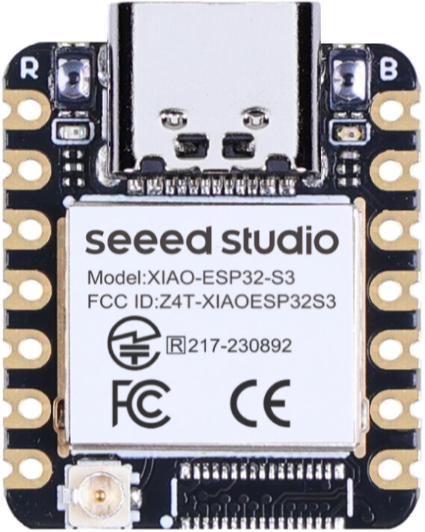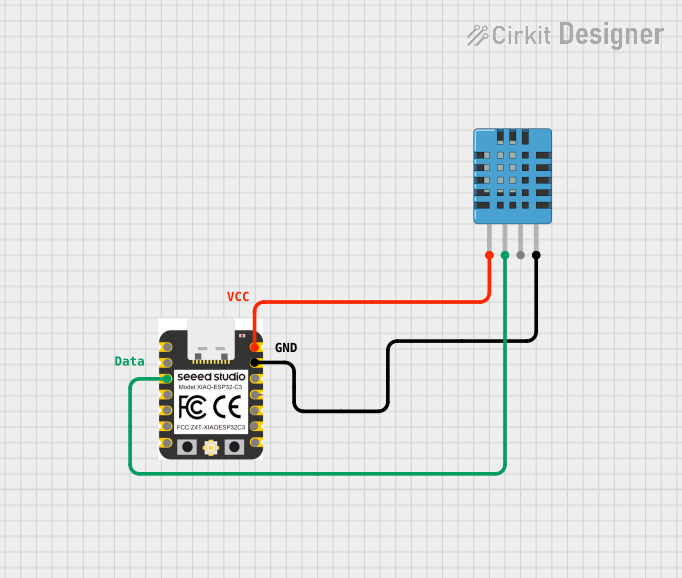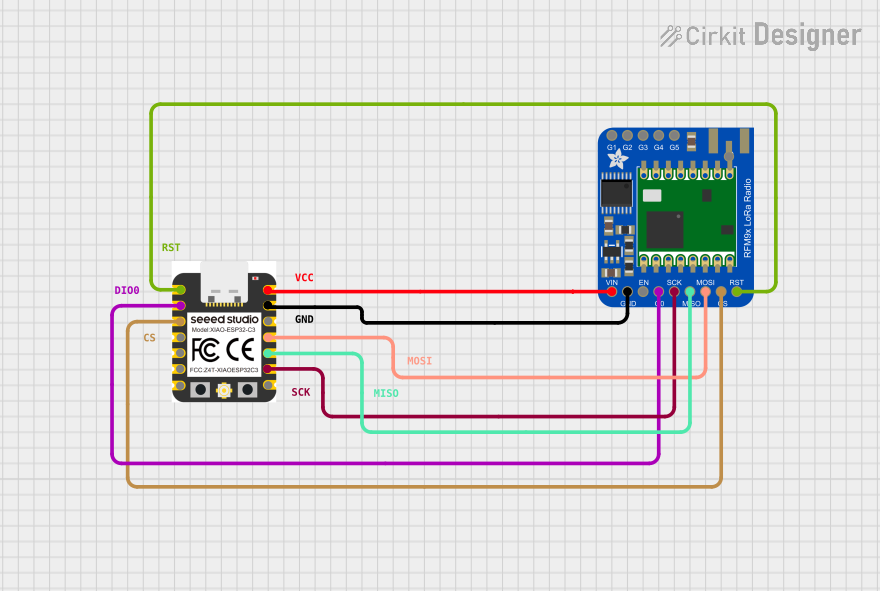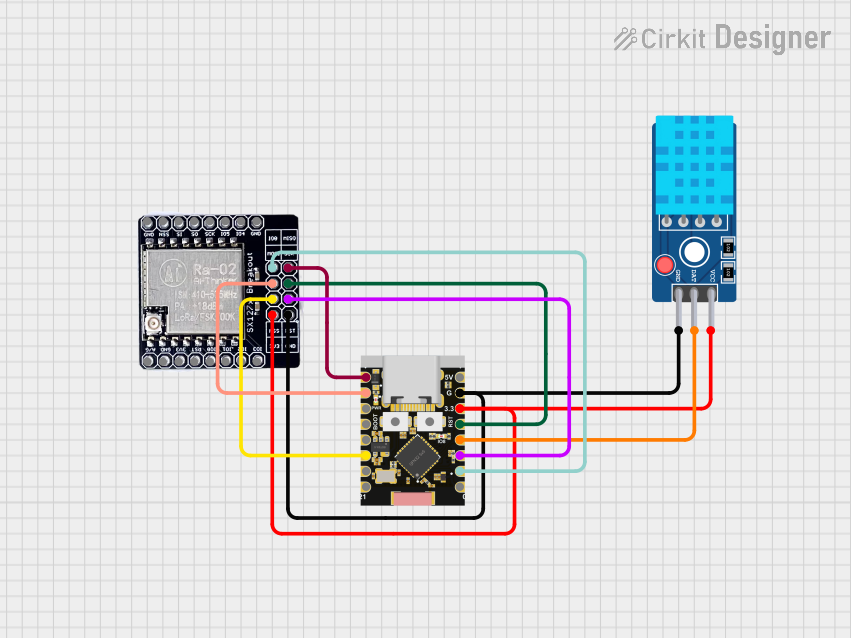
How to Use Seeed Xiao ESP32-S3: Examples, Pinouts, and Specs

 Design with Seeed Xiao ESP32-S3 in Cirkit Designer
Design with Seeed Xiao ESP32-S3 in Cirkit DesignerIntroduction
The Seeed Xiao ESP32-S3 (Manufacturer Part ID: 113991114) is a compact and powerful microcontroller board designed by Seeedstudio. It is based on the ESP32-S3 chip, which features dual-core Xtensa LX7 processors, built-in Wi-Fi, and Bluetooth 5.0 LE capabilities. This board is ideal for Internet of Things (IoT) applications, wearable devices, and other projects requiring wireless connectivity in a small form factor.
With its rich set of GPIO pins, low power consumption, and support for AI acceleration, the Seeed Xiao ESP32-S3 is a versatile choice for developers and hobbyists alike. Its compatibility with popular development platforms like Arduino IDE and CircuitPython makes it accessible to users of all skill levels.
Explore Projects Built with Seeed Xiao ESP32-S3

 Open Project in Cirkit Designer
Open Project in Cirkit Designer
 Open Project in Cirkit Designer
Open Project in Cirkit Designer
 Open Project in Cirkit Designer
Open Project in Cirkit Designer
 Open Project in Cirkit Designer
Open Project in Cirkit DesignerExplore Projects Built with Seeed Xiao ESP32-S3

 Open Project in Cirkit Designer
Open Project in Cirkit Designer
 Open Project in Cirkit Designer
Open Project in Cirkit Designer
 Open Project in Cirkit Designer
Open Project in Cirkit Designer
 Open Project in Cirkit Designer
Open Project in Cirkit DesignerCommon Applications
- IoT devices and smart home automation
- Wearable electronics
- Wireless data logging and monitoring
- AI and machine learning applications
- Robotics and sensor networks
Technical Specifications
Key Technical Details
| Specification | Value |
|---|---|
| Microcontroller | ESP32-S3 (Xtensa® 32-bit LX7 dual-core) |
| Clock Speed | Up to 240 MHz |
| Flash Memory | 8 MB |
| PSRAM | 8 MB |
| Wireless Connectivity | Wi-Fi 802.11 b/g/n, Bluetooth 5.0 LE |
| Operating Voltage | 3.3V |
| Input Voltage Range | 5V (via USB-C) |
| GPIO Pins | 11 (including ADC, I2C, SPI, UART, PWM) |
| USB Interface | USB-C (supports programming and power) |
| Dimensions | 21 x 17.5 mm |
| Power Consumption (Idle) | ~10 mA |
| AI Acceleration | Support for vector instructions and ML |
Pin Configuration and Descriptions
| Pin Name | Pin Number | Functionality |
|---|---|---|
| 3V3 | 1 | 3.3V power output |
| GND | 2 | Ground |
| D0 | 3 | GPIO, UART RX, ADC, PWM |
| D1 | 4 | GPIO, UART TX, ADC, PWM |
| D2 | 5 | GPIO, I2C SDA, ADC, PWM |
| D3 | 6 | GPIO, I2C SCL, ADC, PWM |
| D4 | 7 | GPIO, SPI MOSI, ADC, PWM |
| D5 | 8 | GPIO, SPI MISO, ADC, PWM |
| D6 | 9 | GPIO, SPI SCK, ADC, PWM |
| D7 | 10 | GPIO, ADC, PWM |
| RST | 11 | Reset pin |
Usage Instructions
How to Use the Seeed Xiao ESP32-S3 in a Circuit
Powering the Board:
- Connect the board to a 5V power source using the USB-C port. The onboard voltage regulator will step down the voltage to 3.3V for the microcontroller.
- Alternatively, you can power the board directly via the 3V3 pin with a regulated 3.3V supply.
Programming the Board:
- Install the necessary drivers and libraries for the ESP32-S3 in your development environment (e.g., Arduino IDE or CircuitPython).
- Select the correct board and port in your IDE.
- Write your code and upload it to the board via the USB-C connection.
Connecting Peripherals:
- Use the GPIO pins to connect sensors, actuators, or other peripherals. Refer to the pin configuration table for specific pin functionalities.
- Ensure that the connected peripherals operate at 3.3V logic levels to avoid damaging the board.
Example: Blinking an LED with Arduino IDE
Here is a simple example to blink an LED connected to pin D2:
// Define the pin where the LED is connected
const int ledPin = 2; // D2 corresponds to GPIO2
void setup() {
// Set the LED pin as an output
pinMode(ledPin, OUTPUT);
}
void loop() {
// Turn the LED on
digitalWrite(ledPin, HIGH);
delay(1000); // Wait for 1 second
// Turn the LED off
digitalWrite(ledPin, LOW);
delay(1000); // Wait for 1 second
}
Important Considerations and Best Practices
- Voltage Levels: Ensure all connected peripherals operate at 3.3V logic levels. Use level shifters if interfacing with 5V devices.
- Power Supply: Avoid exceeding the input voltage range (5V via USB-C or 3.3V via 3V3 pin) to prevent damage.
- Heat Management: While the board is efficient, prolonged high-performance tasks may cause slight heating. Ensure proper ventilation if used in enclosed spaces.
- Firmware Updates: Regularly check for firmware updates to ensure compatibility and access to the latest features.
Troubleshooting and FAQs
Common Issues and Solutions
The board is not detected by the computer:
- Ensure the USB-C cable is a data cable (not just a charging cable).
- Check if the necessary drivers for the ESP32-S3 are installed on your computer.
- Try a different USB port or cable.
Code upload fails:
- Verify that the correct board and port are selected in your IDE.
- Press and hold the reset button while uploading the code to enter bootloader mode.
Wi-Fi or Bluetooth is not working:
- Ensure the correct libraries (e.g.,
WiFi.horBluetoothSerial.h) are included in your code. - Check that your router or Bluetooth device is within range.
- Ensure the correct libraries (e.g.,
Peripherals are not responding:
- Double-check the wiring and connections.
- Confirm that the peripherals are compatible with 3.3V logic levels.
FAQs
Q: Can I use the Seeed Xiao ESP32-S3 with CircuitPython?
A: Yes, the board is compatible with CircuitPython. You can download the appropriate firmware from the CircuitPython website and flash it to the board.
Q: What is the maximum current output of the 3V3 pin?
A: The 3V3 pin can supply up to 500 mA, depending on the input power source.
Q: Does the board support deep sleep mode?
A: Yes, the ESP32-S3 supports deep sleep mode for ultra-low power consumption, making it ideal for battery-powered applications.
Q: Can I use this board for AI/ML applications?
A: Absolutely! The ESP32-S3 includes support for vector instructions and AI acceleration, making it suitable for lightweight AI/ML tasks.
This documentation provides a comprehensive guide to using the Seeed Xiao ESP32-S3. For further assistance, refer to the official Seeedstudio documentation or community forums.